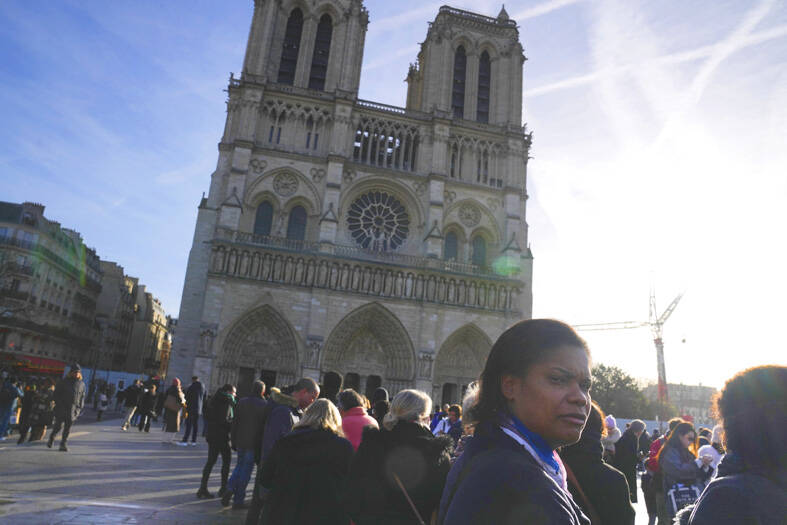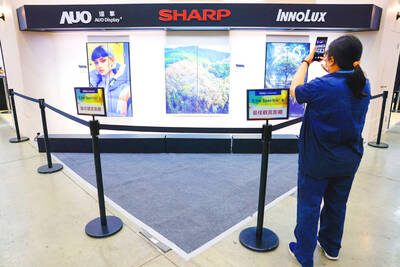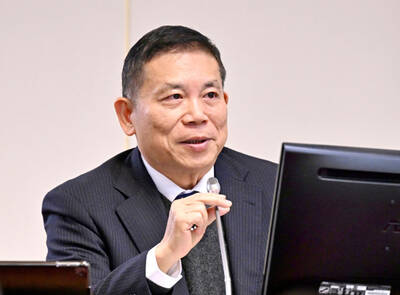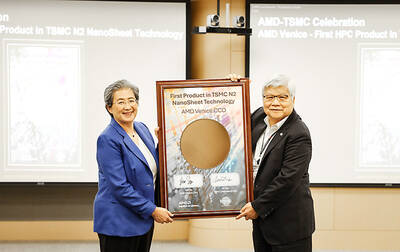Holidaymakers are returning to Paris for winter holiday magic as the tourism industry rebounds, inspired by the successful Olympic Games and the reopening of Notre-Dame cathedral.
“This year there is much more tourism than last time I came here. Much, much more. Many more people,” said Noemi Rizzato, a tourist from Milan who braved the cold to visit the Place du Trocadero, bundled up in her down jacket.
Georges Bardot, a 78-year-old pensioner from eastern France, also pointed to large numbers of foreign tourists amid the holiday hustle and bustle in the City of Light.

Photo: AP
“We heard every language except French spoken on the Metro,” Bardot laughed.
This winter, Parisian hotels are experiencing a surge in demand.
The booking rate for two-week Christmas vacations neared 70 percent in the middle of this month, nine percentage points higher than a year ago, data from MKG Consulting showed.
Top-of-the-range establishments are doing particularly well, with an increase of about 14 points over one year.
Well-heeled international customers are making a comeback, the UMIH hotel and restaurant union said.
UMIH president for the Paris region Frank Delvau pointed to an “Olympic effect.”
The Games “have made tourists want to come back, or to visit,” he said.
Tourism professionals said the world’s largest sporting event led to a lackluster summer in Paris.
Wealthy Parisians fled the capital for the summer and many foreign holidaymakers chose to stay away due to transport gridlock and a security crackdown. Hotels and airlines such as Air France saw a drop in bookings, while taxi drivers and restaurant owners said their businesses had been badly affected.
With 5 billion viewers, the Paris Games were the most followed Games in television and social media history, according to the International Olympic Committee.
“We needed this catch-up effect, because the situation was very difficult in the third quarter,” Delvau said.
“There was a very sharp fall in visitor numbers. The restaurant business was down 40 percent, 50 percent at times,” he added.
From Nov. 1 to Dec. 8, international air arrivals to Paris rose by 15.4 percent compared with last year, to reach 1.3 million, the Paris Tourist Office said.
On the Ile de la Cite, the island site of Notre-Dame cathedral, shopkeepers eagerly await the return of visitors after five years of reconstruction work, as well as the COVID-19 lockdowns that saw a drop in tourist numbers.
“The Notre-Dame opening this year was the biggest item on our list,” said Teju Arora, an engineer from the US.
“And we did visit Notre-Dame, it was amazing. It’s a beautiful site and it was great to see, to pray, to visit,” said Arora, wearing a red beret.
About 270,000 people have visited the medieval masterpiece in the first eight days since Notre-Dame reopened in early this month, rector Olivier Ribadeau Dumas told French daily Le Parisien.
“Around 30,000 people a day enter the cathedral,” Dumas said.
Tourists “tell themselves it’s time to go to Paris,” Delvau said. “They have both Notre-Dame and the department stores’ windows, which always attract a lot of people.”

UNCERTAINTY: Innolux activated a stringent supply chain management mechanism, as it did during the COVID-19 pandemic, to ensure optimal inventory levels for customers Flat-panel display makers AUO Corp (友達) and Innolux Corp (群創) yesterday said that about 12 to 20 percent of their display business is at risk of potential US tariffs and that they would relocate production or shipment destinations to mitigate the levies’ effects. US tariffs would have a direct impact of US$200 million on AUO’s revenue, company chairman Paul Peng (彭雙浪) told reporters on the sidelines of the Touch Taiwan trade show in Taipei yesterday. That would make up about 12 percent of the company’s overall revenue. To cope with the tariff uncertainty, AUO plans to allocate its production to manufacturing facilities in

TAKING STOCK: A Taiwanese cookware firm in Vietnam urged customers to assess inventory or place orders early so shipments can reach the US while tariffs are paused Taiwanese businesses in Vietnam are exploring alternatives after the White House imposed a 46 percent import duty on Vietnamese goods, following US President Donald Trump’s announcement of “reciprocal” tariffs on the US’ trading partners. Lo Shih-liang (羅世良), chairman of Brico Industry Co (裕茂工業), a Taiwanese company that manufactures cast iron cookware and stove components in Vietnam, said that more than 40 percent of his business was tied to the US market, describing the constant US policy shifts as an emotional roller coaster. “I work during the day and stay up all night watching the news. I’ve been following US news until 3am

Taiwan will prioritize the development of silicon photonics by taking advantage of its strength in the semiconductor industry to build another shield to protect the local economy, National Development Council (NDC) Minister Paul Liu (劉鏡清) said yesterday. Speaking at a meeting of the legislature’s Economics Committee, Liu said Taiwan already has the artificial intelligence (AI) industry as a shield, after the semiconductor industry, to safeguard the country, and is looking at new unique fields to build more economic shields. While Taiwan will further strengthen its existing shields, over the longer term, the country is determined to focus on such potential segments as

COLLABORATION: Given Taiwan’s key position in global supply chains, the US firm is discussing strategies with local partners and clients to deal with global uncertainties Advanced Micro Devices Inc (AMD) yesterday said it is meeting with local ecosystem partners, including Taiwan Semiconductor Manufacturing Co (TSMC, 台積電), to discuss strategies, including long-term manufacturing, to navigate uncertainties such as US tariffs, as Taiwan occupies an important position in global supply chains. AMD chief executive officer Lisa Su (蘇姿丰) told reporters that Taiwan is an important part of the chip designer’s ecosystem and she is discussing with partners and customers in Taiwan to forge strong collaborations on different areas during this critical period. AMD has just become the first artificial-intelligence (AI) server chip customer of TSMC to utilize its advanced